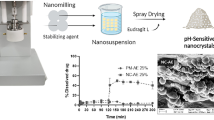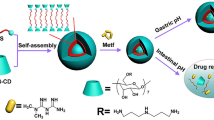Abstract
Luteolin suffers from drawbacks like low solubility and bioavailability, thus hindering its application in the clinic. In this study, we employed sodium dodecyl sulfate (SDS), an efficient tight junction opening agent, to modify the surface of luteolin nanocrystals, aiming to enhance the bioavailability of luteolin (LUT) and luteolin nanocrystals (LNC). The particle sizes of SDS-modified luteolin nanocrystals (SLNC) were slightly larger than that of LNC, and the zeta potential of LNC and SLNC was −25.0 ± 0.7 mV and −43.5 ± 0.4 mV, respectively. Both LNC and SLNC exhibited enhanced saturation solubility and high stability in the liquid state. In the cellular study, we found that SDS has cytotoxicity on caco-2 cells and could open the tight junction of the caco-2 monolayer, which could lead to an enhanced transport of luteolin across the intestinal membrane. The bioavailability of luteolin was enhanced for 1.90-fold by luteolin nanocrystals, and after modification with SDS, the bioavailability was enhanced to 3.48-fold. Our experiments demonstrated that SDS could efficiently open the tight junction and enhance the bioavailability of luteolin thereafter, revealing the construction of SDS-modified nanocrystals is a good strategy for enhancing the oral bioavailability of poorly soluble drugs like luteolin.









Similar content being viewed by others
References
Lin LC, Pai YF, Tsai TH. Isolation of luteolin and luteolin-7-O-glucoside from Dendranthema morifolium Ramat Tzvel and their pharmacokinetics in rats. J Agric Food Chem. 2015;63:7700–6.
Dong X, Lan W, Yin X, Yang C, Wang W, Ni J. Simultaneous determination and pharmacokinetic study of quercetin, luteolin, and apigenin in rat plasma after oral administration of Matricaria Chamomilla L. extract by HPLC-UV. Evid-Based Compl Alt. 2017;2017:8370584.
Seelinger G, Merfort I, Schempp CM. Anti-oxidant, anti-inflammatory and anti-allergic activities of luteolin. Planta Med. 2008;74:1667–77.
Ahmed S, Khan H, Fratantonio D, Hasan MM, Sharifi S, Fathi N, et al. Apoptosis induced by luteolin in breast cancer: mechanistic and therapeutic perspectives. Phytomedicine. 2019;59:152883.
Wang Q, Wang H, Jia Y, Pan H, Ding H. Luteolin induces apoptosis by ROS/ER stress and mitochondrial dysfunction in gliomablastoma. Cancer Chemother Pharmacol. 2017;79:1031–41.
Zhu S, Lei S, Zhou S. Luteolin shows antidepressant-like effect by inhibiting and downregulating plasma membrane monoamine transporter (PMAT, Slc29a4). J Funct Foods. 2019;54:440–8.
Tan L, Liang C, Wang Y, Jiang Y, Zeng S, Tan R. Pharmacodynamic effect of luteolin micelles on alleviating cerebral ischemia reperfusion injury. Pharmaceutics. 2018;10:248.
Dang H, Meng M, Zhao H, Iqbal J, Dai R, Deng Y, et al. Luteolin-loaded solid lipid nanoparticles synthesis, characterization, & improvement of bioavailability, pharmacokinetics in vitro and vivo studies. J Nanopart Res. 2014;16:2347.
Khan J, Alexander A, Ajazuddin SS, Saraf S. Luteolin phospholipid-complex: preparation, characterization and biological evaluation. J Pharm Pharmacol. 2014;66:1451–62.
Puhl AC, Fagundes M, dos Santos KC, Polikarpov I, das Silva MF, Fernandes JB, et al. Preparation and characterization of polymeric nanoparticles loaded with the flavonoid Luteolin, by using factorial design. Int J Drug Deliv. 2011;3:683–98.
Cheng M, Yuan F, Liu J, Liu W, Feng J, Jin Y, et al. Fabrication of fine puerarin nanocrystals by Box–Behnken Design to enhance intestinal absorption. AAPS PharmSciTech. 2020;21:1080–5.
Lu Y, Chen Y, Gemeinhart RA, Wu W, Li T. Developing nanocrystals for cancer treatment. Nanomedicine-UK. 2015;10:2537–52.
Liu J, Tu L, Cheng M, Feng J, Jin Y. Mechanisms for oral absorption enhancement of drugs by nanocrystals. J Drug Deliv Sci Tech. 2020;56:101607.
Müller RH, Peters K. Nanosuspensions for the formulation of poorly soluble drugs: I. preparation by a size-reduction technique. Int J Pharm. 1998;160:229–37.
Aziz F, Fatima A, Khalique CK, Mahomed FM. Prandtl’s boundary layer equation for two-dimensional flow: exact solutions via the simplest equation method. Math Probl Eng. 2013;724385.
Mou D, Chen H, Wan J, Xu H, Yang X. Potent dried drug nanosuspensions for oral bioavailability enhancement of poorly soluble drugs with pH-dependent solubility. Int J Pharm. 2011;413:237–44.
Liversidge GG, Conzentino P. Drug particle size reduction for decreasing gastric irritancy and enhancing absorption of naproxen in rats. Int J Pharm. 1995;125:309–13.
Mohammad IS, Hu H, Yin L, He W. Drug nanocrystals: fabrication methods and promising therapeutic applications. Int J Pharm. 2019;562:187–202.
Quan P, Shi K, Piao H, Piao H, Liang N, Xia D, et al. A novel surface modified nitrendipine nanocrystals with enhancement of bioavailability and stability. Int J Pharm. 2012;430:366–71.
Wang J, Kong M, Zhou Z, Yan D, Yu X, Cheng X, et al. Mechanism of surface charge triggered intestinal epithelial tight junction opening upon chitosan nanoparticles for insulin oral delivery. Carbohydr Polym. 2017;157:596–602.
Bocsik A, Grof I, Kiss L, Otvos F, Zsiros O, Daruka L, et al. Dual action of the PN159/KLAL/MAP peptide: increase of drug penetration across caco-2 intestinal barrier model by modulation of tight junctions and plasma membrane permeability. Pharmaceutics. 2019;11:73.
Yi Y, Tu L, Hu K, Wu W, Feng J. The construction of puerarin nanocrystals and its pharmacokinetic and in vivo–in vitro correlation (IVIVC) studies on beagle dog. Colloids Surf, B. 2015;133:164–70.
Annika T, Jouni H, Leena P. Stabilizing agents for drug nanocrystals: effect on bioavailability. Pharmaceutics. 2016;8:16.
Yu Q, Wang Z, Li P, Yang Q. The effect of various absorption enhancers on tight junction in the human intestinal Caco-2 cell line. Drug Dev Ind Pharm. 2013;39:587–92.
Lin P, Chuang E, Chiu Y, Chen H, Lin K, Juang J, et al. Safety and efficacy of self-assembling bubble carriers stabilized with sodium dodecyl sulfate for oral delivery of therapeutic proteins. J Control Release. 2017;259:168–75.
Real D, Hoffmann S, Leonardi D, Salomon C, Goycoolea FM. Chitosan-based nanodelivery systems applied to the development of novel triclabendazole formulations. PLoS One. 2018;13:e0207625.
Mauludin R, Müller RH, Keck CM. Kinetic solubility and dissolution velocity of rutin nanocrystals. Eur J Pharm Sci. 2009;36:502–10.
Liu M, Zhang J, Zhu X, Shan W, Li L, Zhong J, et al. Efficient mucus permeation and tight junction opening by dissociable “mucus-inert” agent coated trimethyl chitosan nanoparticles for oral insulin delivery. J Control Release. 2016;222:67–77.
Yeh TH, Hsu LW, Tseng MT, Lee PL, Sonjae K, Ho YC, et al. Mechanism and consequence of chitosan-mediated reversible epithelial tight junction opening. Biomaterials. 2011;32:6164–73.
Quan YS, Hattori K, Lundborg E, Fujita T, Murakami M, Muranishi S, et al. Effectiveness and toxicity screening of various absorption enhancers using caco-2 cell monolayers. Biol Pharm Bull. 1998;21(6):615–20.
Tu L, Cheng M, Sun Y, Fang Y, Liu J, Liu W, et al. Fabrication of ultra-small nanocrystals by formation of hydrogen bonds: in vitro and in vivo evaluation. Int J Pharm. 2020;573:118730.
Matsusaki M, Hikimoto D, Nishiguchi A, Kadowaki K, Ohura K, Imai T, et al. 3D-fibroblast tissues constructed by a cell-coat technology enhance tight-junction formation of human colon epithelial cells. Biochem Bioph Res Co. 2015;475:363–9.
Kaiser M, Pereira S, Pohl L, Ketelhut S, Kemper B, Gorzelanny C, et al. Chitosan encapsulation modulates the effect of capsaicin on the tight junctions of MDCK cells. Sci Rep-UK. 2015;5:1038.
Begletsova N, Selifonova E, Chumakov A, Al-Alwani A, Zakharevich A, Chernova R, et al. Chemical synthesis of copper nanoparticles in aqueous solutions in the presence of anionic surfactant sodium dodecyl sulfate. Colloids Surf A. 2018;552:75–80.
Xie J, Luo Y, Chen Y, Ma Y, Yue P, Yang M. Novel breviscapine nanocrystals modified by panax notoginseng saponins for enhancing bioavailability and synergistic anti-platelet aggregation effect. Colloids Surf, B. 2019;175:333–42.
Kumar R, Siril PF. Enhancing the solubility of fenofibrate by nanocrystal formation and encapsulation. AAPS PharmSciTech. 2018;9:284–92.
Du J, Zhou Y, Wang L, Wang Y. Effect of PEGylated chitosan as multifunctional stabilizer for deacetylmycoepoxydience nanosuspension design and stability evaluation. Carbohydr Polym. 2016;153:471–81.
Chen T, Tu L, Wang G, Qi N, Wu W, Zhang W, et al. Multi-functional chitosan polymeric micelles as oral paclitaxel delivery systems for enhanced bioavailability and anti-tumor efficacy. Int J Pharm. 2020;578:119105.
Fares AR, Elmeshad AN, Kassem MAA. Enhancement of dissolution and oral bioavailability of lacidipine via pluronic P123/F127 mixed polymeric micelles: formulation, optimization using central composite design and in vivo bioavailability study. Drug Deliv. 2018;25:132–42.
Tu L, Yi Y, Wu W, Hu F, Hu K, Feng J. Effects of particle size on the pharmacokinetics of puerarin nanocrystals and microcrystals after oral administration to rat. Int J Pharm. 2013;458:135–40.
Li Y, Miao X, Chen T, Yi X, Wang R, Zhao H, et al. Zebrafish as a visual and dynamic model to study the transport of nanosized drug delivery systems across the biological barriers. Colloids Surf, B. 2017;156:227–35.
Amelsberg A, Schteingart CD, Stein J, Simmonds WJ, Sawada GA, Ho NF, et al. Intestinal absorption of sodium dodecyl sulfate in the rodent: evidence for paracellular absorption. Am J Physiol-Gastr L. 1997;272:498–506.
Liu M, Zhong X, Yang Z. Chitosan functionalized nanocochleates for enhanced oral absorption of cyclosporine A. Sci Rep-UK. 2017;7:41322.
ACKNOWLEDGEMENTS
This work was supported by the National Natural Science Foundation of China (81960717), the Health and Family Planning Commission of Jiangxi Province (2018B011, 20195652) and the “1050” Young Talent Scholar discipline project of Jiangxi University of TCM (JXSYLXK-ZHYA0015).
Author information
Authors and Affiliations
Corresponding authors
Ethics declarations
Ethics Statement
All procedures were approved by the Animal Research Ethics Committee, Jiangxi University of Traditional Chinese Medicine.
Conflict of Interest
The authors declare no competing interests.
Additional information
Publisher’s Note
Springer Nature remains neutral with regard to jurisdictional claims in published maps and institutional affiliations.
Supplementary Information
ESM 1
(DOCX 443 kb)
Rights and permissions
About this article
Cite this article
Liu, J., Sun, Y., Cheng, M. et al. Improving Oral Bioavailability of Luteolin Nanocrystals by Surface Modification of Sodium Dodecyl Sulfate. AAPS PharmSciTech 22, 133 (2021). https://doi.org/10.1208/s12249-021-02012-y
Received:
Accepted:
Published:
DOI: https://doi.org/10.1208/s12249-021-02012-y




